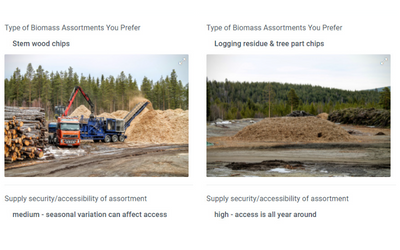Industrial end-users’ preferred characteristics for wood biomass feedstocks
Scientific paper published in Energies (in Open Access), based on a project co-funded by IEA Bioenergy Task 43 (Biomass supply). Available at: https://www.mdpi.com/1996-1073/15/10/3721
The article belongs to the Special Issue Sustainable Biomass Supply Integration for Bioenergy within the Broader Bioeconomy https://www.mdpi.com/journal/energies/special_issues/sustainable_biomass_supply_integration
The use of sustainably sourced biomass is an important tool for mitigating the effects of climate change; but biomass is far from being a homogeneous resource. Biohubs are increasingly recognized as important part in an effective raw material supply chain for pulp and paper and biomaterial industries and the energy sector. The design of biohubs and their functionality highly depends on the type, amount and quality of industrial feedstock demand, which, among other factors, are key measures to optimize raw material utilization efficiency. Today most large forest industry terminals are specialized for either industrial roundwood supplies or biomass for energy deliveries. However along with advances in production processes and upscaling of existing forest industry facilities (mainly pulp and paper mills) and by adding adjacent biorefinery units to them, a number of biomass assortments such as roundwood, logging residues, bark, chips, preprocessed biomass etc. can be stored, their quality and bulk density can be modified and delivered from one joint biohub.
The aim of this study was to examine the decision-making process of industrial end-users considering biomass procurement. A survey was held with experienced professionals, representing a portfolio of facilities varying in size, technology, and biomass types, across Australia, Canada, Finland, and Sweden.
The results provided an insight into end-users’ views on factors including facility location, size, and biomass storage, handling, and procurement for different wood-based industrial services. The most important decision-making attribute appeared to be the type of biomass assortment, at individual, national, and aggregated levels. Of seven sub-categories of biomass assortments, sawdust (35%) was the most preferred type followed by stem wood chips (20%) and energy wood (15%). We concluded that, from the end-user’s perspective, a pre-defined biomass assortment is the most important factor when deciding on feedstock procurement at a bioenergy facility. These results help us better understand end-users’ perceptions of biomass properties in relation to their conversion processes and supply preferences and can inform product development and the securement of new niches in alternative business environments by existing and future biohubs.
Full reference:
Kons, K.; Blagojevi´c, B.; Mola-Yudego, B.; Prinz, R.; Routa, J.; Kulisic, B.; Gagnon, B.; Bergström, D. Industrial End-Users’ Preferred Characteristics for Wood Biomass Feedstocks. Energies 2022, 15, 3721. https://doi.org/10.3390/en15103721
Short summary:
Summary Report – Industrial end-users’ preferred characteristics for wood biomass feedstocks

Figure: examples of feedstock options in the survey


